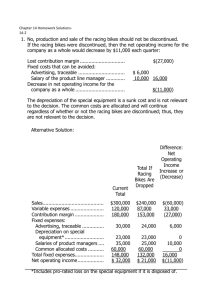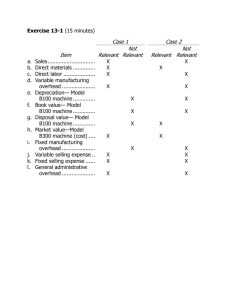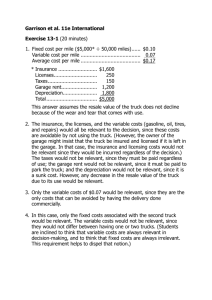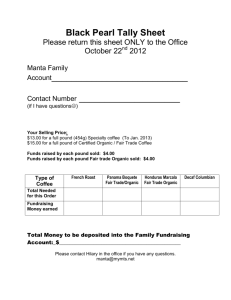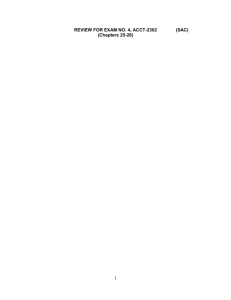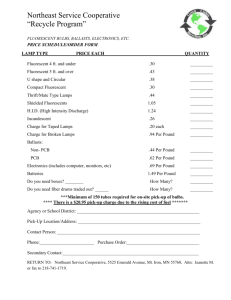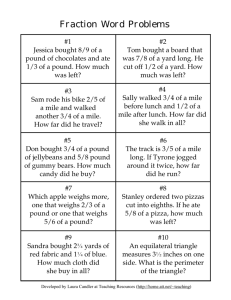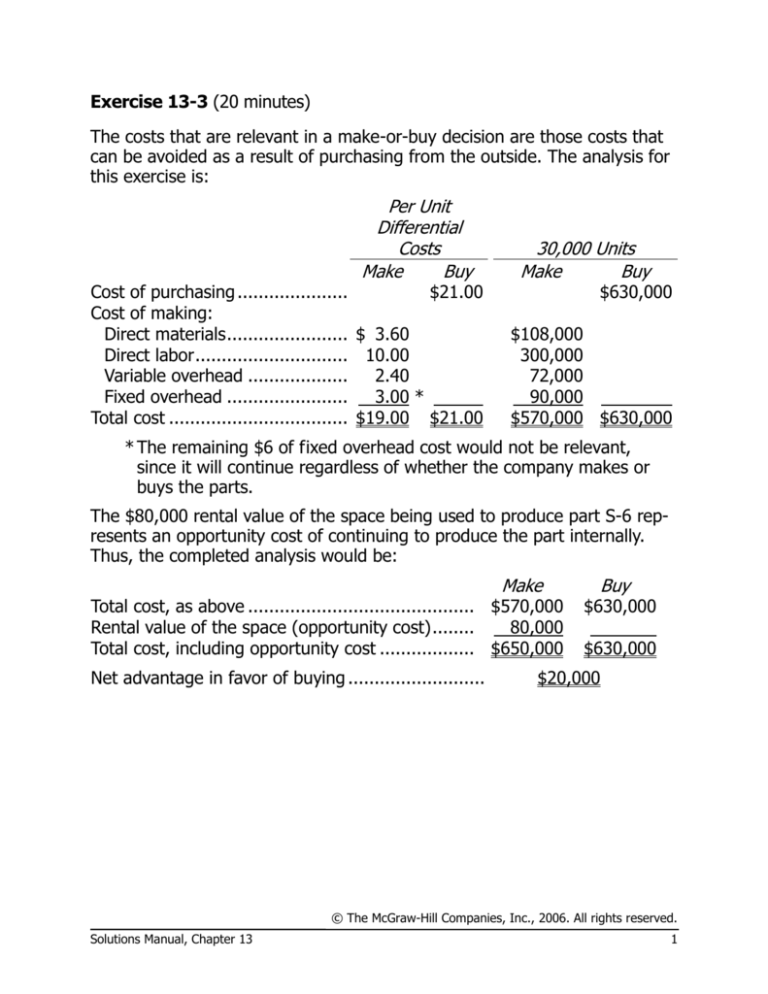
Exercise 13-3 (20 minutes)
The costs that are relevant in a make-or-buy decision are those costs that
can be avoided as a result of purchasing from the outside. The analysis for
this exercise is:
Per Unit
Differential
Costs
Make
Buy
Cost of purchasing .....................
$21.00
Cost of making:
Direct materials ....................... $ 3.60
Direct labor ............................. 10.00
Variable overhead ...................
2.40
Fixed overhead .......................
3.00 *
Total cost .................................. $19.00 $21.00
30,000 Units
Make
Buy
$630,000
$108,000
300,000
72,000
90,000
$570,000 $630,000
* The remaining $6 of fixed overhead cost would not be relevant,
since it will continue regardless of whether the company makes or
buys the parts.
The $80,000 rental value of the space being used to produce part S-6 represents an opportunity cost of continuing to produce the part internally.
Thus, the completed analysis would be:
Make
Total cost, as above ........................................... $570,000
Rental value of the space (opportunity cost) ........
80,000
Total cost, including opportunity cost .................. $650,000
Net advantage in favor of buying ..........................
Buy
$630,000
$630,000
$20,000
© The McGraw-Hill Companies, Inc., 2006. All rights reserved.
Solutions Manual, Chapter 13
1
Exercise 13-4 (15 minutes)
1. Annual profits will be increased by $39,000:
Incremental sales ..................................
Incremental costs:
Direct materials ..................................
Direct labor ........................................
Variable manufacturing overhead.........
Variable selling and administrative .......
Total incremental costs ..........................
Incremental profits................................
Per Unit
15,000
Units
$14.00 $210,000
5.10
76,500
3.80
57,000
1.00
15,000
1.50
22,500
11.40 171,000
$ 2.60 $ 39,000
The fixed costs are not relevant to the decision, since they will be incurred regardless of whether the special order is accepted or rejected.
2. The relevant cost is $1.50 (the variable selling and administrative expenses). All other variable costs are sunk, since the units have already
been produced. The fixed costs would not be relevant, since they will
not change in total as a consequence of the price charged for the leftover units.
© The McGraw-Hill Companies, Inc., 2006. All rights reserved.
2
Managerial Accounting, 11th Edition
Exercise 13-11 (30 minutes)
1.
A
B
(1) Contribution margin per unit ...........................................
$54 $108
(2) Direct material cost per unit ...........................................
$24 $72
(3) Direct material cost per pound ........................................
$8
$8
(4) Pounds of material required per unit (2) ÷ (3) .................
3
9
(5) Contribution margin per pound (1) ÷ (4) .........................
$18 $12
C
$60
$32
$8
4
$15
2. The company should concentrate its available material on product A:
A
B
C
Contribution margin per pound (above) ...........................
$
18 $
12 $
15
Pounds of material available ............................................
× 5,000 × 5,000 × 5,000
Total contribution margin ................................................
$90,000 $60,000 $75,000
Although product A has the lowest contribution margin per unit and the
second lowest contribution margin ratio, it is preferred over the other
two products since it has the greatest amount of contribution margin
per pound of material, and material is the company’s constrained resource.
3. The price Barlow Company would be willing to pay per pound for additional raw materials depends on how the materials would be used. If
there are unfilled orders for all of the products, Barlow would presumably use the additional raw materials to make more of product A. Each
pound of raw materials used in product A generates $18 of contribution
margin over and above the usual cost of raw materials. Therefore, Barlow should be willing to pay up to $26 per pound ($8 usual price plus
$18 contribution margin per pound) for the additional raw material, but
would of course prefer to pay far less. The upper limit of $26 per pound
to manufacture more product A signals to managers how valuable additional raw materials are to the company.
If all of the orders for product A have been filled, Barlow Company
would then use additional raw materials to manufacture product C. The
company should be willing to pay up to $23 per pound ($8 usual price
plus $15 contribution margin per pound) for the additional raw materials
to manufacture more product C, and up to $20 per pound ($8 usual
price plus $12 contribution margin per pound) to manufacture more
product B if all of the orders for product C have been filled as well.
© The McGraw-Hill Companies, Inc., 2006. All rights reserved.
Solutions Manual, Chapter 13
3
Exercise 13-12 (10 minutes)
A
B
C
Selling price after further processing .....
$20
$13
$32
Selling price at the split-off point ..........
16
8
25
Incremental revenue per pound or
gallon ...............................................
$4
$5
$7
Total quarterly output in pounds or
gallons ............................................. ×15,000 ×20,000 ×4,000
Total incremental revenue .................... $60,000 $100,000 $28,000
Total incremental processing costs ........ 63,000
80,000 36,000
Total incremental profit or loss ............. $(3,000) $ 20,000 $(8,000)
Therefore, only product B should be processed further.
© The McGraw-Hill Companies, Inc., 2006. All rights reserved.
4
Managerial Accounting, 11th Edition


